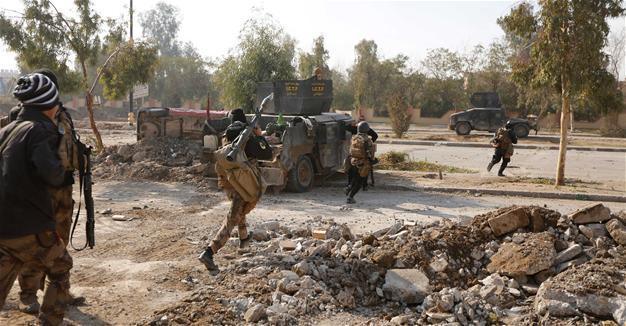Iraqi forces link up in north Mosul, make gains in southeast
BAGHDAD/ARBIL
 Iraqi forces joined flanks in northern Mosul and drove back the Islamic State of Iraq and the Levant (ISIL) militants in the southeast on Jan. 12 in a renewed push that has brought them closer to controlling the eastern half of the city.
Iraqi forces joined flanks in northern Mosul and drove back the Islamic State of Iraq and the Levant (ISIL) militants in the southeast on Jan. 12 in a renewed push that has brought them closer to controlling the eastern half of the city. Elite Counter Terrorism Service (CTS) units also reached the southern 2nd Bridge, also called the Freedom Bridge, one of five running across the river that bisects Mosul from north to south, the military statement reported by state TV said, according to Reuters.
Iraqi forces, who are fighting in eastern Mosul, have now reached two of the bridges, and battled their way to the southernmost 4th Bridge several days ago.
All the bridges have been hit by U.S. coalition air strikes in an effort to hamper ISIL militants’ movement across the city. U.S. and Iraqi military officials say ISIL has caused further damage to at least two of them to try to hamper any Iraqi advance across the river.
Further north, CTS forces took control of 7th Nissan and Sadeeq districts, linking up with army troops that had pushed through al-Hadba neighborhood, CTS spokesman Sabah al-Numan told Reuters.
“This is considered contact between the troops of the northern front and CTS. This... will prevent any gap between the axes which the enemy could use,” he said by phone. “The enemy is now located only in front of the troops, not at their sides.”
Numan said more than 85 percent of eastern Mosul was now under control of pro-government forces, up from nearly 75 percent a week ago.
Brett McGurk, Washington’s envoy to the U.S.-led coalition backing the Iraqi offensive with air strikes, training and advice, called the link-up a “milestone” and said in a tweet that ISIL’s defenses were weakening.
In Mosul’s northeast, CTS forces fought their way into the Mosul University area and were near the technical college on the eastern side of the campus, a Reuters reporter at the front lines said.
An Iraqi officer said army units backed by air strikes had also taken control of Hadba district, north of the university, and would aid the assault on the complex.
When it launched the offensive in October 2016, the Iraqi government hoped to have retaken the city by the end of 2016, but Iraqi Prime Minister Haider al-Abadi said last month that it could now take another three months to drive the militants out.
















